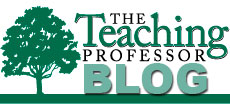Here are two frequently asked questions about exam review sessions: (1) Is it worth devoting class time to review, and (2) How do you get students, rather than the teacher, doing the reviewing? Instead of answering those questions directly, I decided a more helpful response might be a set of activities that can make exam review sessions more effective.
 1. What’s going to be on the test? Students take two or three minutes to look over their notes and maybe skim the text, and then they jot down five things (maybe a few more or less) they are confident will be on the exam. They then form groups of three to five students, and each group constructs an agreed-upon list to give to the teacher. The teacher combines the group submissions to create a list for the class, and the list is made available to students in advance of the exam. During the exam debrief, the list is retrieved so students can see the items on the list that were also on the test. The teacher can almost always make this point: with a bit of classmate collaboration, you can come up with a pretty good answer to the question of what’s going to be on the test.
1. What’s going to be on the test? Students take two or three minutes to look over their notes and maybe skim the text, and then they jot down five things (maybe a few more or less) they are confident will be on the exam. They then form groups of three to five students, and each group constructs an agreed-upon list to give to the teacher. The teacher combines the group submissions to create a list for the class, and the list is made available to students in advance of the exam. During the exam debrief, the list is retrieved so students can see the items on the list that were also on the test. The teacher can almost always make this point: with a bit of classmate collaboration, you can come up with a pretty good answer to the question of what’s going to be on the test.
2. What will the test questions be like? Again in small groups, students are assigned a different section of the text, notes from a lecture, or specific topics, and they are charged with writing a designated number of test questions. Note: writing good test questions of any kind isn’t easy, so don’t expect perfection. Offering some guidelines for the type of questions that will be on the exam is helpful. Compile the student-generated questions, maybe add a few of your questions, and use them during the second half of the period. Let students work on the questions in their groups, which you can then score and maybe give members in the group with the highest score a few bonus points. Debrief the activity with some feedback on the student-generated questions. Too easy? Unclear? Unimportant content?
3. What content would be helpful in answering test questions? Individually or in groups, students review material (or you can assign groups a designated content chunk) and create a crib sheet. These crib sheets—whether a single sheet, half sheet, or index card—should contain material students would like to be able to use during the exam. This content does not answer potential questions but is the material needed to construct answers. Students could use the crib sheets during all or part of the exam; you decide. If you have them turn in their sheets, you can return them attached to the exam. An alternative review session could have you distributing group crib sheets for students to evaluate and in the process clarifying what answers they will need to know for the exam.
4. What makes an answer good? Use a short answer or essay question with relevant exam content, and then construct or use from a previous exam three answers at different quality levels. Avoid both awful and superstar answers. Students grade the answers individually first; then they evaluate them as a group, focusing on what differentiates them, both with the goal of concretely identifying features of a good answer. Follow up with a new question (maybe a different one for each group), and task them with identifying the content needed to construct a good answer. Share with the whole class what each group produces.
5. How should I be studying for the exam? Students tend to be pretty generic in their thinking about study strategies. “I’ll go over my notes” and “I’ll reread what I’ve highlighted in the text.” If your students don’t have stellar study skills, a list of possible study strategies might be helpful in guiding this discussion in small groups or with the whole class. Recommend what research in cognitive psychology has shown promotes learning and test performance: studying for shorter periods across several days, testing knowledge with questions (those in the book, provided by the teacher, or made up on their own), working on different types of problems, reviewing with a study buddy, and reworking (not recopying) class notes. Encourage students to develop a study plan and to try one or several study strategies they haven’t used before. Later, during the exam debrief, have a follow-up discussion. What strategies did they try? What worked? What didn’t? Let the class develop a set of recommended study strategies that could be shared in subsequent courses.
Now it’s your turn. Please add your favorite exam review activities to this collection.




